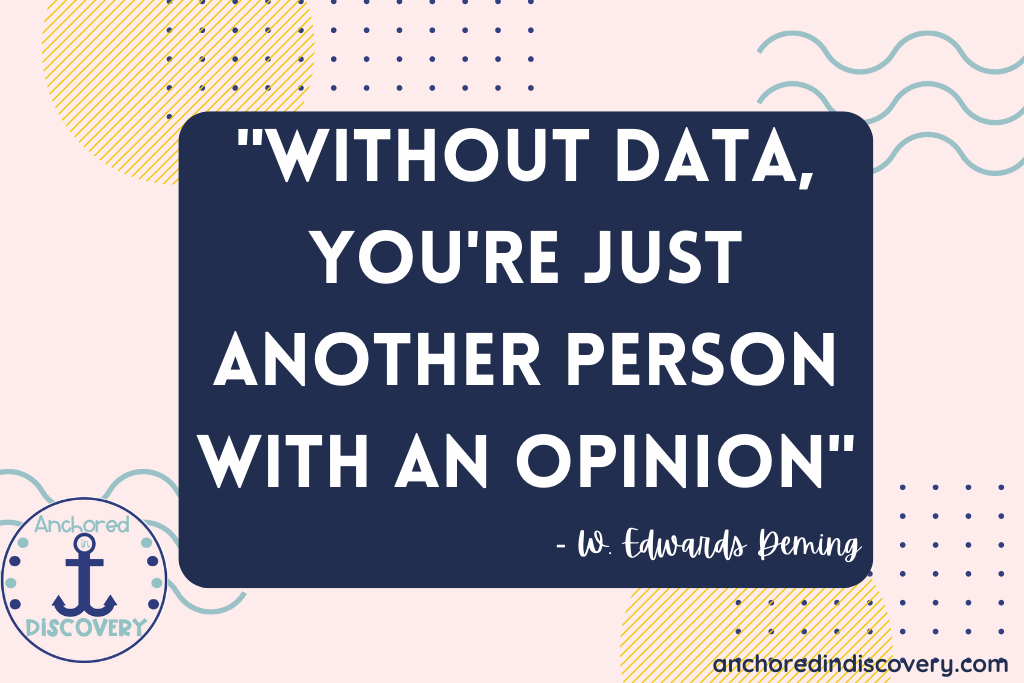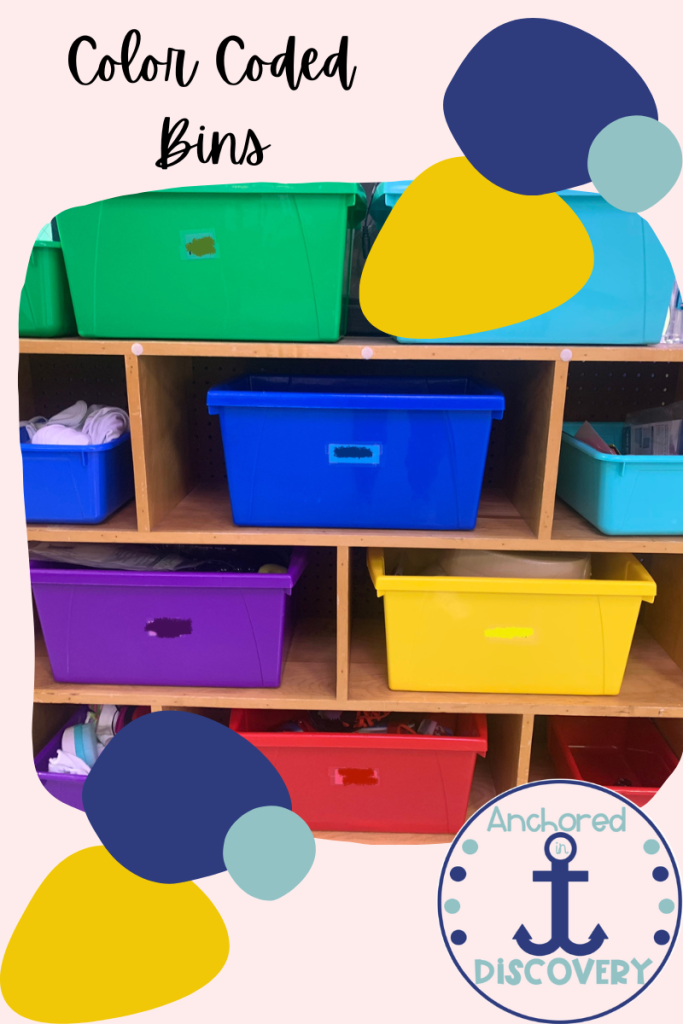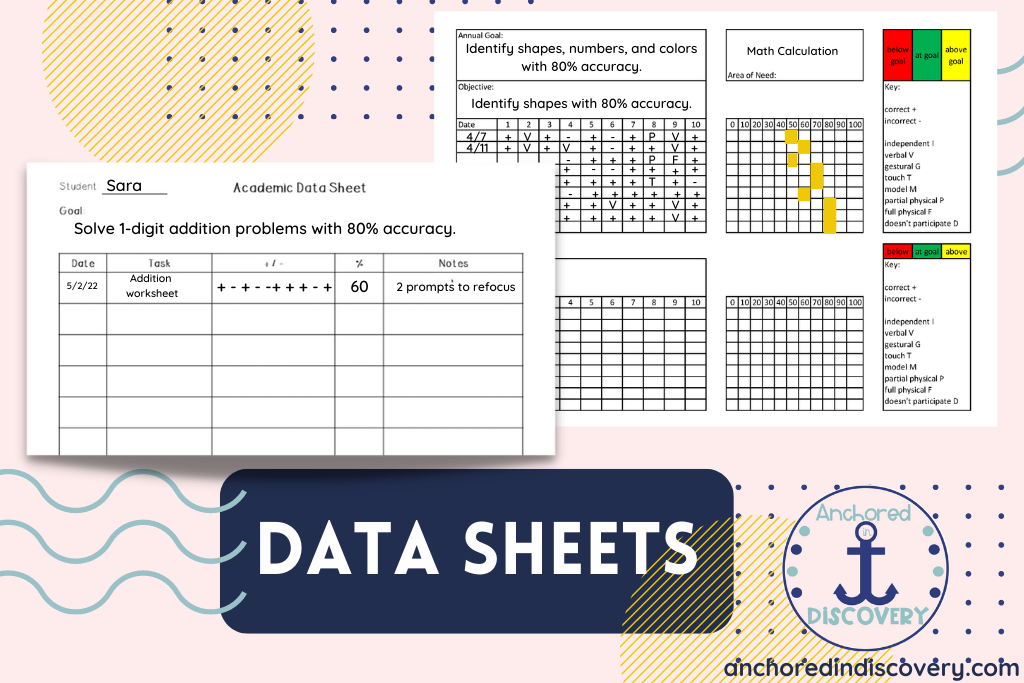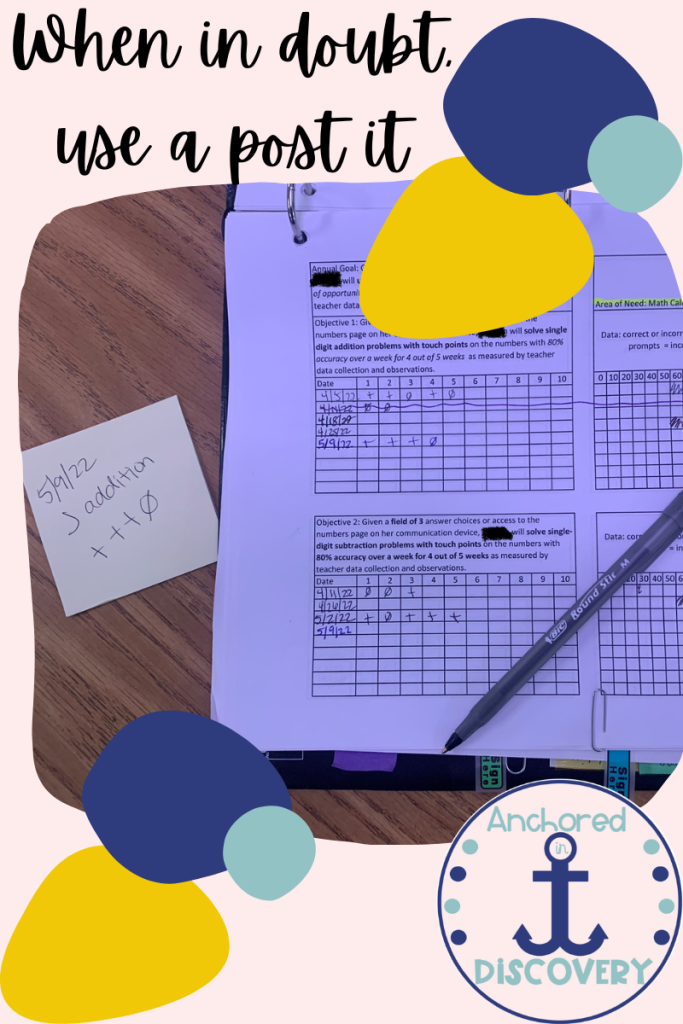
05 Jul How to Make Effective IEP Goal Data Collection Simple
Let’s face it; IEP goal data collection is overwhelming. Multiple students, multiple goals, and multiple areas of exceptionality are a lot to keep track of.
During my first two years of teaching, taking data in the classroom consistently was not my strength. I would often forget to write in the data sheets when working on the goal and I’ve even forgotten about an entire objective until I got to the progress report and realized I hadn’t taken any data on it. Embarrassing to admit, but it’s the truth. Data collection for special education teachers is no joke.
Even as I became more experienced and stopped forgetting goals I needed data on, I still struggled. Data collection is left behind the second a student is having a hard day that requires my attention or I get stuck in a long meeting. I had to figure out how to make taking data in the classroom a regular part of my day without creating a classroom that is all about testing and data. Keep reading to see how I organize my data and create user-friendly systems that make IEP goal data collection easier.

What is IEP goal data collection and why is it important?
Every student with an IEP (individualized education plan) has goals they are working on. The goals are decided during the annual IEP meeting based on the child’s current levels and where the team wants to see them grow. Some goals have objectives or small goals that need to be mastered before meeting the goal.
How many goals and what type of goals depends on the child’s needs. For example, a student with dyslexia may only have a goal in reading; they are meeting expectations in all other areas. However, most students with significant disabilities are exceptional in multiple areas, including, but not limited to, all areas of reading and math, pre-vocational skills, adaptive skills, communication, and social-emotional skills. This typically means they have multiple IEP goals and objectives. The students on my current caseload have between 6 and 12 IEP goals.
Data collection for special education teachers is a crucial requirement of our job. Without data, it would be impossible for us to know objectively if a student has made progress. And, like all of us, our students have up and down days, so we must take data regularly and avoid relying on one or two pieces of data throughout a quarter.
IEP goal data collection is also important because it informs our instruction. If I see a student who hasn’t made any progress on a goal after 3 weeks, I can change my intervention. If I don’t take data frequently, I’ll miss the indicators that signal a change in instruction is needed.
One last point regarding the importance of taking data in the classroom – documenting regular, consistent data will protect you as a teacher if anyone ever questions your instruction. Parents, advocates, specialists, or administrators may request to see your IEP data collection sheets and you want to make sure you are organized and prepared to show off all the great things you are doing with your students! In short, high-quality data collection will benefit your teaching, and your student’s progress, and allow you to show others what is happening in your classroom.
Start with organization
“Work smarter, not harder.” As cliche as this saying is, it is so true for teachers. Spend time on the front end setting up easy and reliable systems. When the day gets crazy (which, let’s be honest, happens more often than not in our job), there isn’t time for creative, cutesy data collection. Organization is key. Here are three things I do to keep data in the classroom organized:
Color Coding
At the start of every year, I assign each student a different color. This color isn’t just for data collection; it’s for all their individualized, specific materials and supplies.
Some of the things I color code by student include:
- Data binders
- Folders that go home each day with the student (home/school communication)
- Labels in their cubbies
- Labels in the bathroom for specific toileting supplies
- Bins containing materials specific to their IEP goals
- Schedules
Color coding everything goes beyond being aesthetically pleasing. Not only does it save me so much time when I’m looking for things but it also helps staff in the room find materials for certain students without having to dig through bins and cabinets. Since color-coding materials, I’ve seen my paraprofessionals take more initiative when working with students since they know what materials are meant for each student and where to find them.

I started color-coding to make data collection easier, but one unexpected benefit of color coding has been increased independence in my students. Especially for my emerging readers, this system helps them find their things. I was shocked to see my students grabbing the right folders to put in their backpacks at the end of the day with no explicit teaching. Increasing independence in my students while also making my life easier is a win-win situation for me!
My bins are Storex brand and I bought them on Amazon:
Data Binders
I’ve taken data in the classroom in many different ways over the years. I tried organizing all the sheets by goal area on different clipboards, putting all the sheets for every student in one big binder, giving each student a different clipboard; the list goes on and on. None of these seemed to work. Clipboards were hard to grab if I had multiple students at one time and one big binder became cumbersome.
The best method for me has been a binder for each student. I separate the binder into 5 sections, but some of the sections will depend on your population of students and their needs.
- General Information: IEP at a Glance, parent contact information, and any medical or behavior documents if applicable (Individualized Health Plans or Behavior Intervention Plans)
- Academic Data: IEP data collection sheets for each goal, separated by Post-It Tabs
- Positioning Data: All of my students have physical disabilities and require positioning changes (e.g. getting in a stander or gait trainer). I track the times they are out of their wheelchairs in this section.
- Bathroom Information: This section is only for students who are not able to toilet independently. For these students, I track how often they are going through the toileting process each day.
- Parent Communication: I keep all of my home-school communication notes when the parents return them. I also log additional contact with them (phone calls, email, in-person conversations). Documentation is so important in special education!

I use 1-inch binders; anything bigger is too difficult to grab quickly when taking data in the classroom. Label the binder with the student’s name using their color and you are ready to go!
IEP Goal Checklists for Data Collection
One problem I consistently run into is keeping track of all the goals I need to take data on. Last year, I started making these checklists that list each goal in a few words and then have empty spots for each day of the week. I used Excel to make these, but any data table would work. After I print them out, I slide them into a Dry Erase Sleeve and hang them by the student’s colored bins containing the materials for their IEP goals. After I work on the goal I check it off for that day with a dry erase marker. Each day, I can quickly look and see which goals haven’t been targeted that week. On Fridays, I make sure I target the remaining goals that haven’t been checked off yet.
These checklists also help other staff easily see what each student is working on. This is especially useful for my related service providers to see what goals we are targeting. My paraprofessionals also regularly use the checklists. When working with students, they know what skills to target and check them off when they finish the activity so I know, even if data wasn’t marked, that the student was exposed to the content.

Since implementing this checklist, I have been able to consistently target all goals regularly. It’s a simple and easy way to track your work throughout the week!
Making IEP data collection sheets
People tend to be particular about how they want their IEP data collection sheets to look and there is no wrong way to do it. The best thing to do is to keep it simple and user-friendly. I don’t like spending hours designing new data sheets every time there is a new goal added. Instead, I’d recommend finding a template you like and sticking with it for most, if not all of your goals. Show it to another teacher or one of your paraprofessionals and see if they understand your data sheets. If not, you might be overcomplicating it. Make sure someone else can pick them up and understand them.
Below are a few special education data sheets I use regularly. You can find these special education data sheets (for free!) on my Teachers Pay Teachers store.

How to make time to take data in the classroom
Plan Ahead
Data collection isn’t pretty and it isn’t always the most fun part of the day. However, it doesn’t have to be stressful or time-consuming. Lesson plan with your student’s IEP goals in mind. Plan which goals you will target during each part of your lesson. Plan to take data on each goal more than once over the week. That way, when things inevitably go wrong one day, you have plenty more opportunities to collect data later in the week.
I also use technology for data collection. When my students are working independently on computers and iPads, I try to be intentional about which apps and activities they are using, and make sure they are tied to their IEP Goals. Boom Cards is one of my favorite apps to use for IEP goal data collection. Click here to read my blog post about using Boom Cards in the special education classroom.
Post-Its are your best friend
Another problem I used to run into was not having the student’s binder in front of me at the right time. Instead of piling up IEP goal binders around the room, I started putting Post-Its at every center. I write the data down on a Post-It, check it off on my checklist, and then add the data to the binder at the end of the day. My paraprofessionals even use the Post-Its to mark data as they work with students. This system is much more user-friendly for them as opposed to marking an official data sheet they might not be as familiar with.

Planning ahead of time and leaving post-its around the room have helped me seamlessly take data while still providing high-quality instruction.
Become a pro at taking IEP data in the classroom
Data collection for special education teachers may seem overwhelming at first, but it is a vital part of our job and, with a few simple changes to your system, taking data in the classroom can be easy. Plan on the front end by organizing your data and materials in color-coded binders and bins. Track your IEP goal data collection on weekly checklists, and, when in doubt, use Post-Its!
More IEP Goal Data Collection Information
Check out these blog posts from a few of my favorite experts in the field.
Especially Education: Data Collection in the Special Ed Classroom
Mrs. D’s Corner: Data Collection for Special Ed Teachers
The Autism Helper: Data Collection Takes a Team
Remember, everyone takes data a little differently, but the important thing is to keep it simple and stay consistent for whatever system works the best for you!
Click here to download my free IEP Goal Data Collection Sheets Bundle on Teachers Pay Teachers. It includes 20 different data sheets to meet all your data needs. Simplify your IEP goal data collection process so you can feel confident monitoring your student’s progress and have more time to focus on all the other responsibilities of being a special education teacher.

